ASUS A88X-Pro Review: Kaveri, Kaveri, Quite Contrary
by Ian Cutress on April 22, 2014 11:59 AM EST- Posted in
- Motherboards
- AMD
- Asus
- Kaveri
ASUS A88X-Pro BIOS
The move to a graphical BIOS gives a motherboard manufacturer more room to grow and expand their options for enthusiasts. Broadly speaking, there are two sets of enthuisasts in this crowd – those that want an easy way to get more performance, and those that want to squeeze every drop they can from the system under their feet. ASUS goes to great lengths to explain to reviewers how the BIOS works and offers access to user guides to explain how each function works, as well as delivering a platform that allows the user to visually identify what each function does. As the ecosystem evolves, ASUS has been in on the positive side of the divide, because users in this market are requesting more than the bare minimum.
The BIOS starts in EZ mode with ASUS’ characteristic design. As the A88X-Pro is in the channel range of motherboards (i.e. neither ROG nor Sabertooth), the color scheme relies on blues and whites to get the messages across.
This frontage contains the useful information that a user (or debugger) will need: the motherboard name, the BIOS version, the CPU installed, the current CPU speed, the memory installed, the CPU temperature, the CPU voltage, where the memory is installed and the current fan speeds. This screen also allows the memory to be adjusted between default and DOCP (XMP for AMD on ASUS, I believe it stands for Digital/Dynamic Over Clocked Profile) as well as the fan profiles of each fan based on pre-determined settings. Users can also select a power saving or performance setting as well as the boot priority. In order to navigate to the advanced menus, there are options at the top and bottom of EZ mode.
The advanced modes offer more information in a more text based format. The BIOS is set out with the tabs at the top, options to the left, information about the option selected on the top right and the controls on the bottom right. Two of the features on the right are Quick Note and Last Modified which are on the Z87 platform. Quick Note allows users to leave messages for future reference, such as settings for overclocks:
Last Modified also pops up before a user exits the BIOS and shows what settings have changed since the BIOS was opened:
The first tab in advanced mode is the My Favorites menu. This screen collates the user selected options to help with faster adjustments. For example, an overclocker may only require several settings (Memory, CPU multiplier, CPU voltage) in order to test their overclocks. This screen is designed to help reduce the scrolling through the options. Users can add options to the My Favorites menu by highlighting an option and pressing F4 or right clicking. Here are some of the ones I usually add to this menu when reviewing an A88X motherboard:
For a more detailed list of overclocking options, these are found in the AI Tweaker menus. ASUS lists these options in stages: first the CPU, then memory, then voltages.
Selecting OC Tuner will enable the TPU setting on the motherboard, whereas the DRAM Timing control gives the memory subtimings for extreme tweaking.
I am typically fond of a variety of automatic overclock options, such as users selecting a frequency and the platform implementing a pre-configured set of voltages and settings. ASUS has shied away from this in recent platforms, preferring the OC Tuner method as a single option, with potentially more in the operating system.
ASUS also uses DIGI+ Power Control if users want to offer more headroom to the power delivery or adjust load line calibrations:
The Advanced tab in Advanced mode gives all the options related to the various controllers on board and input/output features. This includes CPU, SATA, USB and IGP configurations, such as IDE/AHCI or forcing integrated graphics or CPU power states.
The Monitor tab gives the results of the temperature, fan control and voltage probes located on the motherboard. Here is also the BIOS fan settings, allowing users a two point fan gradient based on power rather than RPM:
The BIOS also contains EZ Flash so users can update the BIOS, SPD information for details about the DRAM being used and OC Profiles for users to save their settings for future use. The Boot menu contains options for faster booting with Windows 8 as well as boot order and boot override.


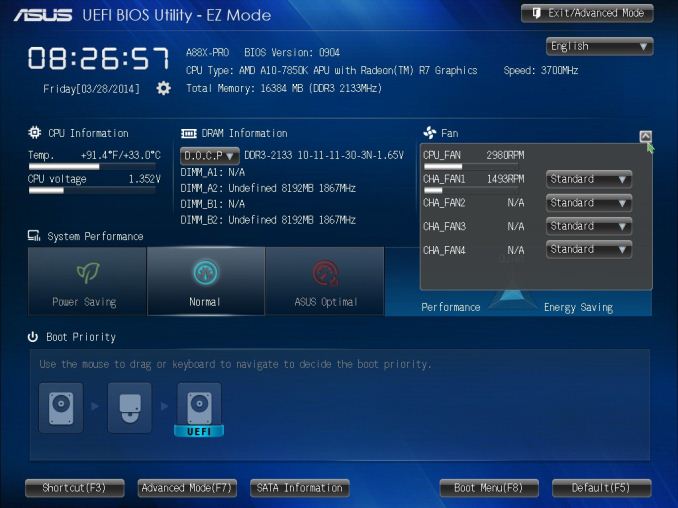
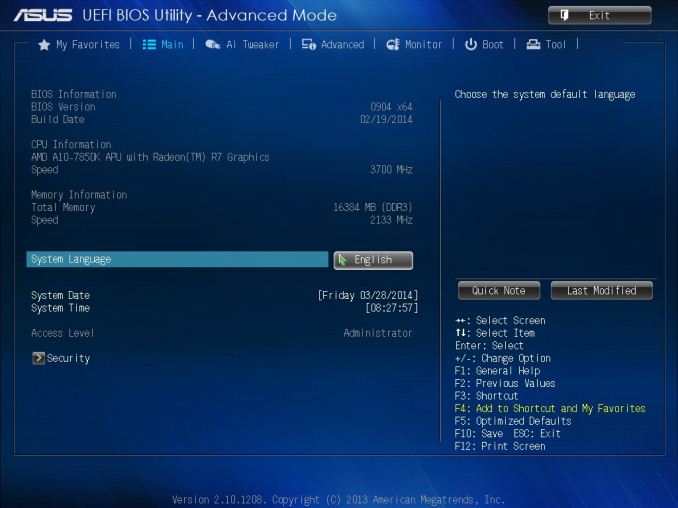

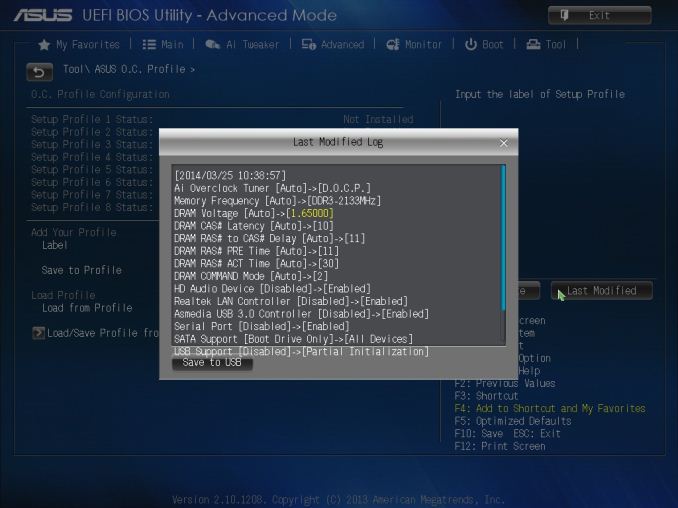


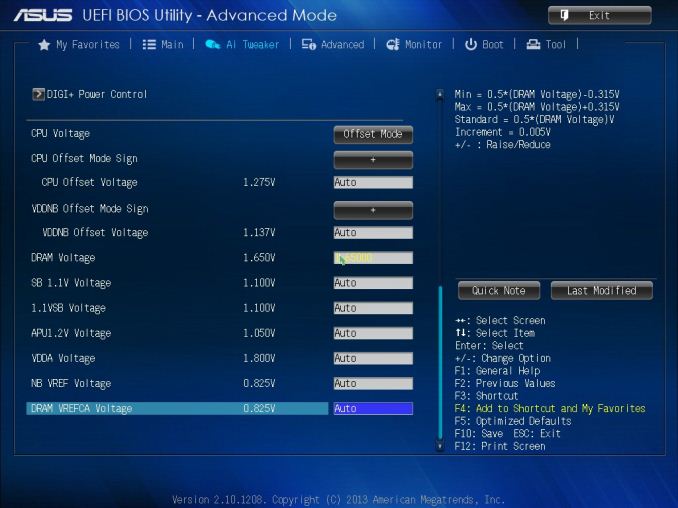
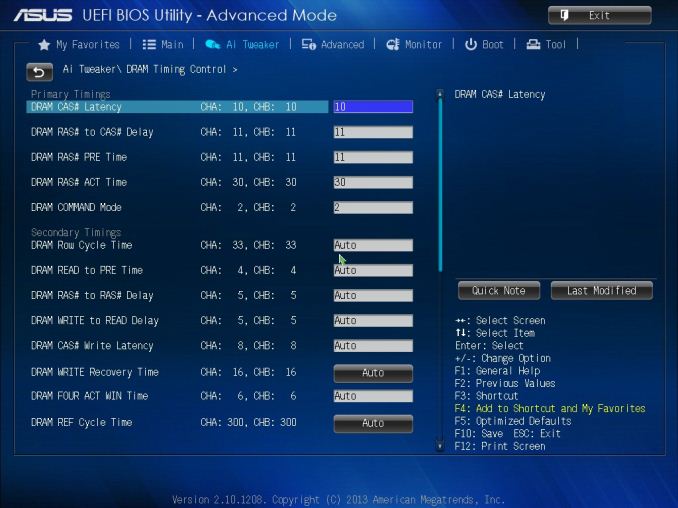

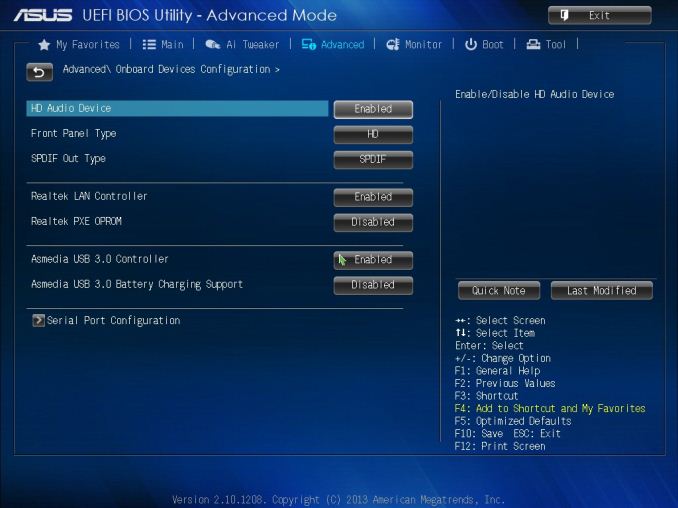
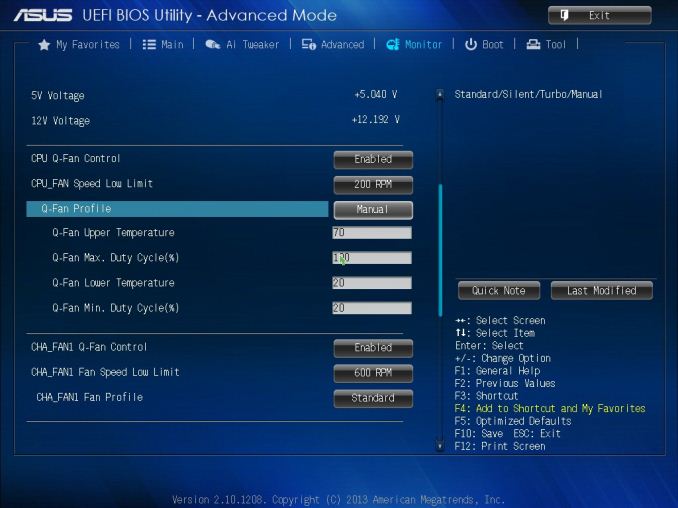














34 Comments
View All Comments
Ortanon - Tuesday, April 22, 2014 - link
EXACTLY. I've been scratching my head on this one. The only possible argument would be that you can cram more gaming into a smaller case, but that's an idiotic argument because 1) who the hell is so desperate to fit a system down to the millimeter and 2) the real-life difference between mini-ITX and micro-ATX cases is often one or two inches in any given dimension.So ultimately Kaveri is, unfortunately, a bust. A moot point. A waste of precious R&D resources. And it's such a shame.
On the bright side, all they'd have to do is adjust the price point. A lot.
Topweasel - Tuesday, April 22, 2014 - link
Obviously you haven't tried to build a computer in SG05 or Ncase M1. Not every ITX case is Prodigy or 250D. Most are much much much smaller in all dimensions than most mATX cases. I would say it's more of the ATX vs mATX that's always bothered me. More often than not an mATX case isn't much smaller than a well spaced full ATX mid tower.That said this motherboard is about as useless as one could be. I see why they are doing it. They want full sized full featured ATX boards for the AMD platform, but with AMD almost completely shutting down AM3+ developments, the future of AMD's platforms is in the FM2 and up. Spending 200$ on a full ATX system just to use integrated video doesn't make sense. I guess one could say there is more performance and power savings when tied to discrete AMD GPU. But APU's are at their best when they are the sole source of video. Certainly not worth spending i5 money otherwise. Which is why it would work best in an ITX setup where both space and cooling are enough of a issue that one would rather do without a discrete card if possible.
PEJUman - Tuesday, April 22, 2014 - link
^^ ThisI was able to purchase the 7850K for 120 at local microcenter and a Asrock A88X-ITX+ for 100 at newegg. At $220 combined price, Kaveri is very hard to pass up. yes, you can get cheaper systems, but it's price/performance/size/power ratio is unique. This is no longer the case if you approach $300. They really need to drop the price down to around 100 for the CPU.
just4U - Tuesday, April 22, 2014 - link
I'd have to agree with that.. Which is why I am waiting on the A8s Their supposed to be priced in and around 90-120 which is somewhat of a sweet spot. As we move up to the 150-180 dollar A10s that drops off a little as you could always pair a discrete card (say a GDR5 240 or something) and blow it all out of the water.BinaryTB - Tuesday, April 22, 2014 - link
HTPCs. Lower heat, lower noise, lower power consumption.CPU and graphics don't matter much if you can decode high bitrate video in hardware and put it all in a small package.
The same argument could be used for laptops as well.
But I do agree with you, if you have a desktop and want performance, separates is the way to go.
eanazag - Tuesday, April 22, 2014 - link
Power consumption and heat are the difference. I do agree with just4U that I really just wanted the A8-7600. With the price about a $100 it makes more sense to me. I think the OEMs cried for it so we got shafted in channel.abufrejoval - Tuesday, April 22, 2014 - link
I'm guessing as to what you'd want: A <95Watt TDP APU, which still has the biggest GPU AMD can make... I think you're willing to sacrifice CPU clock for low TDP, but not graphics performance and would like to hit the 65 or 45 Watt "sweet spots", right?Well you don't need to actually wait for anything: These APUs are all one single die anyway, including all the mobile variants (once they come).
And, at least on Asus, you have the ability to configure your desired TDP in the BIOS, at least between 40 (could be 45) and 65 Watts.
Here is what happens:
You leave that setting alone, you'll get a 95Watts part, which means 3.7 GHz base, while it will clock to 4.0GHz as long as the thermal budget lasts.
You set it to any number between 65 and 40/45 and you'll get exactly that: An APU which will fiddle with GPU and CPU budgets until they meet your TDP limit.
You use single threaded CPU load at 45Watts TDP, you may well get 4.0 GHz for quite a while.
You use tons of GPU, your CPU may well slow to the 1 GHz range (actually I believe it won't drop below 1.6GHz).
So with previous generation APUs like Trinity and Richmond the TDP settings were hard-wired into the die before packaging and sale. With Kaveri, from what I am seeing, there is really just two variants: One with 512 graphic cores enabled and one with 384 graphic cores enabled. Everything else is configuration done completely in software, which is just perfect from where I stand ;-)
I can buy a Kaveri today and push it to its absolute limits with heavy overclock on a "Pro" mainboard and I can transfer it into a mini-ITX board tomorrow and tell it to never use beyond 45Watts and it will just do as it was told!
Completely anti-market-segmentation and just the way I like it as a *consumer*.
pidgin - Tuesday, April 22, 2014 - link
I really regret going with ASRock FM2A88X Killer+, nothing but memory problems, basically no driver updates on driver page, ughhtuklap - Friday, April 25, 2014 - link
seems that you have to take it unto asrock.. I was targetting ASRock FM2A88X Killer+ too but when I read some problems and noticed that there are no driver updates i switched my eye to asrock fm2+ extreme6+ ^_^ never had problems.. although I wish they have esd protections and anti-surge ic's placed on the board. also they should have made it sturdier.all in all quite happy.
this board is solid. but the thing here is it lacks on board switches for power and reset
tech6 - Tuesday, April 22, 2014 - link
I'm sure this is a great boar but none of this matters until AMD release a CPU that is power consumption and performance competitive with what Intel is currently offering. The AMD on board graphics are great but the rest of the CPU and the power consumption are currently simply not competitive.